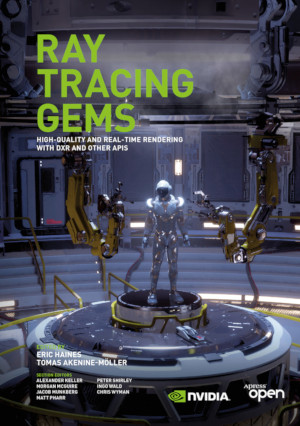Ray Tracing Gems
High-Quality and Real-Time Rendering with DXR and Other APIs
by Eric Haines, Tomas Akenine-Möller
DescriptionTable of ContentsDetailsHashtagsReport an issue
What you'll learn: The latest ray tracing techniques for developing real-time applications in multiple domains; Guidance, advice, and best practices for rendering applications with Microsoft DirectX Raytracing (DXR); How to implement high-performance graphics for interactive visualizations, games, simulations, and more.
Who this book is for: Developers who are looking to leverage the latest APIs and GPU technology for real-time rendering and ray tracing; Students looking to learn about best practices in these areas; Enthusiasts who want to understand and experiment with their new GPUs. 






Book Description
This book is a must-have for anyone serious about rendering in real time. With the announcement of new ray tracing APIs and hardware to support them, developers can easily create real-time applications with ray tracing as a core component. As ray tracing on the GPU becomes faster, it will play a more central role in real-time rendering. Ray Tracing Gems provides key building blocks for developers of games, architectural applications, visualizations, and more. Experts in rendering share their knowledge by explaining everything from nitty-gritty techniques that will improve any ray tracer to mastery of the new capabilities of current and future hardware.What you'll learn: The latest ray tracing techniques for developing real-time applications in multiple domains; Guidance, advice, and best practices for rendering applications with Microsoft DirectX Raytracing (DXR); How to implement high-performance graphics for interactive visualizations, games, simulations, and more.
Who this book is for: Developers who are looking to leverage the latest APIs and GPU technology for real-time rendering and ray tracing; Students looking to learn about best practices in these areas; Enthusiasts who want to understand and experiment with their new GPUs.
This open book is licensed under a Creative Commons License (CC BY-NC-ND). You can download Ray Tracing Gems ebook for free in PDF format (33.3 MB).
Table of Contents
Preface
Foreword
Contributors
Notation
PART I
Ray Tracing Basics
Chapter 1
Ray Tracing Terminology
Chapter 2
What is a Ray?
Chapter 3
Introduction to DirectX Raytracing
Chapter 4
A Planetarium Dome Master Camera
Chapter 5
Computing Minima and Maxima of Subarrays
PART II
Intersections and Efficiency
Chapter 6
A Fast and Robust Method for Avoiding Self-Intersection
Chapter 7
Precision Improvements for Ray/Sphere Intersection
Chapter 8
Cool Patches: A Geometric Approach to Ray/Bilinear Patch Intersections
Chapter 9
Multi-Hit Ray Tracing in DXR
Chapter 10
A Simple Load-Balancing Scheme with High Scaling Efficiency
PART III
Reflections, Refractions, and Shadows
Chapter 11
Automatic Handling of Materials in Nested Volumes
Chapter 12
A Microfacet-Based Shadowing Function to Solve the Bump Terminator Problem
Chapter 13
Ray Traced Shadows: Maintaining Real-Time Frame Rates
Chapter 14
Ray-Guided Volumetric Water Caustics in Single Scattering Media with DXR
PART IV
Sampling
Chapter 15
On the Importance of Sampling
Chapter 16
Sampling Transformations Zoo
Chapter 17
Ignoring the Inconvenient When Tracing Rays
Chapter 18
Importance Sampling of Many Lights on the GPU
PART V
Denoising and Filtering
Chapter 19
Cinematic Rendering in UE4 with Real-Time Ray Tracing and Denoising
Chapter 20
Texture Level of Detail Strategies for Real-Time Ray Tracing
Chapter 21
Simple Environment Map Filtering Using Ray Cones and Ray Differentials
Chapter 22
Improving Temporal Antialiasing with Adaptive Ray Tracing
PART VI
Hybrid Approaches and Systems
Chapter 23
Interactive Light Map and Irradiance Volume Preview in Frostbite
Chapter 24
Real-Time Global Illumination with Photon Mapping
Chapter 25
Hybrid Rendering for Real-Time Ray Tracing
Chapter 26
Deferred Hybrid Path Tracing
Chapter 27
Interactive Ray Tracing Techniques for High-Fidelity Scientific Visualization
PART VII
Global Illumination
Chapter 28
Ray Tracing Inhomogeneous Volumes
Chapter 29
Efficient Particle Volume Splatting in a Ray Tracer
Chapter 30
Caustics Using Screen-Space Photon Mapping
Chapter 31
Variance Reduction via Footprint Estimation in the Presence of Path Reuse
Chapter 32
Accurate Real-Time Specular Reflections with Radiance Caching
Book Details
Title
Ray Tracing Gems
Subject
Computer Science
Publisher
Apress
Published
2019
Pages
607
Edition
1
Language
English
ISBN13
9781484244265
ISBN10
1484244265
ISBN13 Digital
9781484244272
ISBN10 Digital
1484244273
PDF Size
33.3 MB
License

Related Books

This book is an overview on CT/X-ray contrast media designed for radiologists and other medical specialists who use contrast media in imaging and interventional procedures as well as related scientists on the use and pharmaceutical aspects of X-ray contrast media. The overall goal of this book is to provide a comprehensive overview relevant for the...

This book provides methods for the estimation of Biomass Water Equivalent (BEW), an essential step for improving the accuracy of area-wide soil moisture by cosmic-ray neutron sensors (CRNS). Three techniques are explained in detail: (i) traditional in-situ destructive sampling, (ii) satellite based remote sensing of plant surfaces, and (iii) biom...

This manuscript discusses the potentials of the approaches as mentioned below to monitor the AIVs in WMW. Molecular diagnostic platforms enable for accurate detection of the AIVs in the feces of infected birds. Similar technologies can be used to determine the bird species through DNA barcoding, enabling non-invasive research on the epidemiology of...

This book gives a complete and comprehensive introduction to the fields of medical imaging systems, as designed for a broad range of applications. The authors of the book first explain the foundations of system theory and image processing, before highlighting several modalities in a dedicated chapter. The initial focus is on modalities that are clo...

Solar energetic particles (SEPs) emitted from the Sun are a major space weather hazard motivating the development of predictive capabilities. This book presents the results and findings of the HESPERIA (High Energy Solar Particle Events forecasting and Analysis) project of the EU HORIZON 2020 programme. It discusses the forecasting operational tool...

Read the tips and tricks recommended by some of the smartest minds in the ASP.NET community.
25 tips from the ASP.NET community for boosting performance in your web applications; Learn the secrets of your fellow developers and read advice from MVPs and other experts; Covers async/await, Web API, ORMs, interactions between your code and your data...

